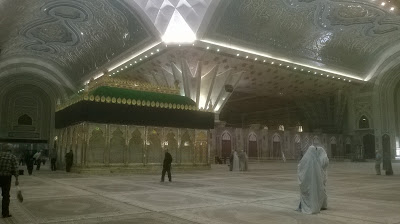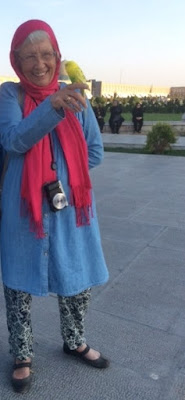 |
| pottery Elamite period bull |
We are in
Tehran
- the capital of
Iran. As I write this it is covered by a
blanket of snow!! When we were there at the end of October it was hot.
 |
| Cuneiform script from Persepolis 5th century BC |
We have travelled through
7000 years of civilization during our amazing trip to Iran over 12
days, and I could happily do this all over again. The country is beautiful, the
people so friendly and welcoming to the many tourists visiting. We met on our
own journey other tour parties from Britain,
France, Holland,
Germany, Australia and Canada
and Russia,
as well as seeing some lone backpackers up in Abyaneh. And we could scarcely
scratch the surface of the treasures the country holds in the time available to
us.
We have seen a 5000 BC archaeological site where remains of humans, their
houses and their pottery have been unearthed.
We visited remnants of the Achaemenid
dynasty (550-330 BCE) at the extraordinary ruins of Pasargadae
and Persepolis,
and at the necropolis of Naqsh-e Rostam.
We visited the hauntingly beautiful
ancient Zoroastrian Sassanid (224 - 658 CE) village
of Abyaneh high in the mountains
between Esfahan and Kashan and the Zoroastrian
Towers of Silence at Yazd,
and enjoyed the wealth of the Safavid court (1501-1736) reflected in the beauty
of Esfahan.
 |
| Bronze statue Parthian nobleman |
In Shiraz we saw a charming example of Zand
(1750-1794) architecture in the 1767 citadel, Arg-e Karim Khan Zand, perhaps
the best surviving example of 18th century fortification in the country. We
visited Kashan, which dates from the 12th century, a town which survived the
Mongol (c 1220-1340) campaigns but is also home to splendid merchants' houses
from the Qajar Dynasty (1757-1924).
 |
| National Museum Tehran |
We have been brought right up the present
day in
Tehran
where tomorrow we will visit the shrine to
Ayatollah Khomeini founder and supreme leader of the Islamic Republic which marked the end of the Shah's
Pahlavi dynasty (1926-1979). He died in 1989.

Much of this history, from
the hunter gatherers of the Lower Paleolithic period to the end of the
Sassanian period is brought together in the
National Museum of Iran which was
our first stop this morning. Here there are
priceless exhibits and an excellent English brochure – make sure you pick this
up as you go in.
On our journey through the city
we pass the
Palestine
roundabout – a mural on the wall alongside shows Palestinians throwing stones
at the Israelis - a significant example of
Iranian graffiti. There is plenty of graffiti in the city, official and otherwise, and some very decorative.
 |
marble throne for Shah by Esfahani craftsmen carved
in 1800s |
 |
| typical Qajar tiling at Golestan |
The population of Tehran is 9 million, with 18 million total counting all the sprawling suburbs.
To the North is a mountain range to which the city dwellers love to escape
where possible. Iran’s
highest peak is here at 5678 metres. Tehran
itself is at 1200 metres altitude. There is a state run university here which
is highly regarded with much competition to be admitted. I see a lovely
pavement sculpture of a girl posting a letter.
We have a great land train
experience – unscheduled I think – and fun! But the land train has a serious
purpose - locals use it all the time to travel up and down the long
pedestrianised shopping street.
 |
| Golestan Palace |
Then we walk on to
the
Golestan museum complex. This is amazing – but photos are forbidden within the complex. We have
also had to leave our bags in the bus as they are not allowed within the
museums.
 |
| Golestan Palace |
The
GolestanPalace (
Palace
of
Flowers) complex, with its ornate
rooms and marble throne, was the seat of power of the Qajar dynasty, became the
official residence of the Royal family and is the oldest historic monument in
Tehran. It would once
have been enclosed within the mud-thatched walls of the historic citadel in the
city.
 |
| street scene Tehran |
 |
| pomegranates for sale Tehran bazaar |
It is now surrounded by the typical city buildings and roads of the 21st
century. Both Reza Khan and Mohammad Reza Pahlavi were crowned here.
The official website supplies some photos and much more
information, albeit with a less than perfect translation.
Afterwards we have a long
walk to pick up the bus – an amazing feat for our driver to even find us in the
midst of total traffic madness! It’s now 1.30 and we have had a very long
morning without refreshment – too long actually and many of us are
wilting!
 |
| land train Tehran |
So we are driven to
Masqh Square
complex where we find our restaurant – this is a top hotel in
Tehran and the meal was
quite the best we had – 10/10! Superb buffet spread with veggies well catered
for – quality sweets and hot drinks – all splendid.
 |
| sculpture at Laleh Park Tehran |
The
National Jewellery
Museum holds many of the
Qajar monarchs’ jewels, safely stored in a bank vault, access to which involves
several security checks and some long waits. But it is all worth it. Again the
official web page supplies the photos
We have a very long wait here
to let the crowds subside and then we seem to go through three different
security processes – including xray machines, and
frisking, before we are allowed through. We then have an official guide to
take us around the circuit – our own guide Ali is not allowed to do this. It is
all very precisely organised. The jewels are priceless, some vulgar, some
exquisite. But it is an interesting experience.
 |
| the Palestine Roundabout Tehran |
I guess everyone visiting Tehran has to experience
the seemingly impossible task of crossing a road! It’s certainly not for the
faint hearted, or to be attempted alone. As a group ably guided by Ali we make
it in one piece! We pick up our bus on the other side of the carriageway, with
some relief.
 |
| typical cabbage decorated roundabout |
Shanderman Restaurant
for supper was superb – excellent veggie meal and meat eaters rated theirs
highly too – very good salad, buffet and soup with choice of meats and tea with
biscuit, coffee or ice cream to finish with a group set meal. 8/10. On our
return to the hotel we give Adrian a book on Persepolis with our thanks
for his excellent leadership throughout the tour. Sad that we have to go
home tomorrow.



















